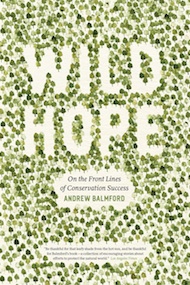By Germaine Cornelissen-Guillaume
This is a rare, somewhat optimistic view on conservation and biodiversity when statistics and news items offer a rather gloomy perspective on the status quo. The glimmer of hope outlined in Andrew Balmford’s book is illustrated by several examples around the planet where conservation efforts appear to be successful. As a professor of conservation science at the University of Cambridge and editor of Conservation in a Changing World, he is well-positioned to critically discuss how conservation efforts are changing and how success can be achieved. He does so by telling stories he witnessed first-hand as he travelled around the world.
The storytelling is engaging and informative as the reader learns about approaches that may lead to a successful outcome and why. It immediately becomes clear that there is no simple recipe for a universal solution. Rather, innovative solutions are needed that are best adapted to each particular situation, while engaging the local populations, governments, academia, and corporations to work together in a collaborative effort to implement them.
One common ingredient, however, is the ability to compromise and to find incentives for all parties involved; in other words, to do what works and not let the best be the enemy of the good.
In the floodplains of Assam in Kaziranga National Park, India, the author illustrates how saving the single-horn rhinos from the brink of extinction takes more than the conventional fines, such as expanding the park’s boundaries and issuing earlier warnings in response to flood-related problems, reintroducing the rhinos into other reserves to spread risks, and finding ways to rehabilitate poachers and to develop innovative measures complementing the tolerance of wildlife by the poor rural population and the bravery and commitment of the park’s rangers.
Closer to home, Balmford brings us to the longleaf pine forests in the Sandhills of North Carolina, home of the red-cockaded woodpecker. This bird ended up at the center of a conflict between conservationists and landowners who saw increased restrictions on the management of their property if it provided the species with habitat, as it is protected under the US Endangered Species Act. These unintended consequences of a well-intended conservation legislation were resolved by the Safe Harbor program. This program allowed landowners to enter into agreements with the Fish and Wildlife Service so that owners’ future rights to modify their property is preserved as long as they currently maintain or improve it for housing federally endangered species. Balmford documents how this incentive helped preserve high-quality habitat for red-cockaded woodpeckers.
In South Africa, Balmford recounts how getting rid of invading exotic plants threatening the exceptional floral diversity of the region could be accomplished by presenting evidence to the post-apartheid government demonstrating how these non-native plants were consuming a lot of scarce water. Funds for their removal also provided jobs and training for thousands of unemployed people, making it an astonishing and comprehensive win-win solution.
Balmford also traveled to the Netherlands, Ecuador, Costa Rica, and Australia. In each of his accounts, he illustrates how success in conservation goes hand-in-hand with powerful partnerships as there is growing recognition that maintaining or restoring ecosystems can also help people. Realistically, he admits that solutions are often imperfect, but he concludes with optimism that conservation success is possible. He singles out as critical ingredients for success: great leadership, patience and resources, daring to think big, a Goldilocks-sized portion of research, creative thinking encompassing the broader picture, playing politics, and aiming for improvement rather than perfection.
Undoubtedly, many challenges remain. The uplifting lesson from Balmford’s book is that, ultimately, it is everybody’s responsibility to do what we can to protect the environment and preserve biodiversity, and that each step toward this goal matters, as long as hope is not lost. Keeping that hope alive is what this book is all about.
Germaine Cornelissen-Guillaume is a professor of integrative biology and physiology and director of the Halberg Chronobiology Center at the University of Minnesota, Twin Cities.




